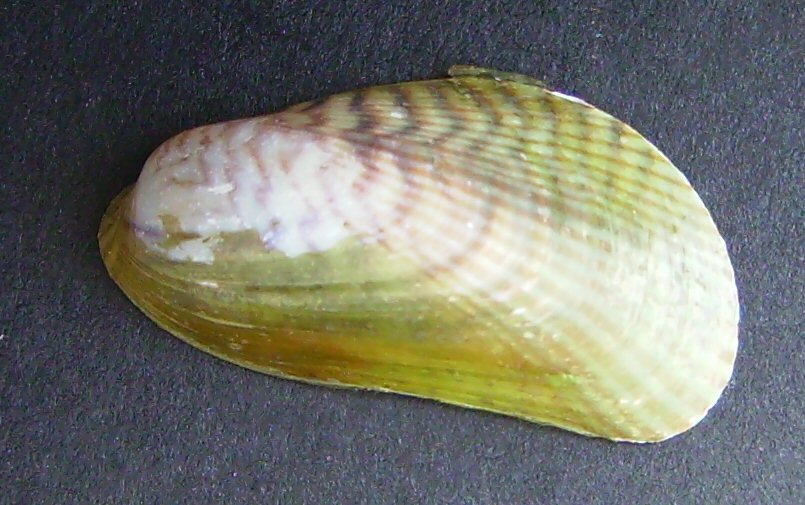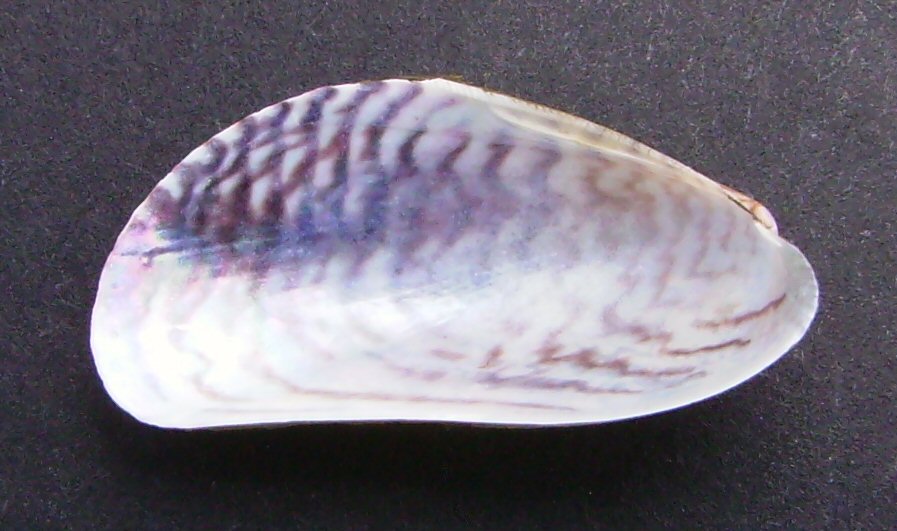Arcuatula senhousia
Asian Bag Mussel
Synonyms: Modiola senhousia, Musculista senhousia
Class: Bivalvia
Order: Mytiloida
Family: Mytilidae


Photographer: Graham Bould
Source: http://commons.wikimedia.org/wiki/Musculista_senhousia
Description
Musculista senhousia is a small olive-green, yellow-green or greenish-brown mussel, which grows to a maximum length of 35 mm but normally it is anywhere from 10-25mm long and 8 mm wide. There are pale purple stripes radiating from the center of growth out to the hind margin of the shell; and often there are dark, purple-brown, zigzag-arcs surrounding the center of growth. The shell is smooth and shiny and the umbo—the hump at the center of growth—is near the head end of the shell. The lower edge of the shell, opposite the hinge, is often slightly concave.
Ecological Threat: May have an adverse impact on biodiversity as it reaches high densities that can exclude other species. Musculista senhousia settles in large groupings, reaching densities up to 150,000 individuals per metres squared. Unlike most mussels, M. senhousia lives entirely within the sediments, surrounded by a bag of byssal threads. At mussel densities greater than 1,500 metres squared, individual byssal bags unite to form a continuous mat on the sediment surface.The presence of these mats dramatically alters the natural benthic habitat, changing both the local physical environment and the native invertebrate groupings. Mussel mats reduce the densities of many common native bivalves and the growth of nearby eelgrass. The Asian date mussel, deposits large amounts of organic matter in the sediment that can result in the accumulation of toxic metabolites such as sulfide; large amounts of sulfide can have detrimental effects on native sea-grass, which is necessary for marine ecosystems along the Pacific coast.
Biology: This mussel takes about 9 months to mature and can live up to 2 years in ideal conditions. Fertilization occurs when male and female mussels secrete sperm and eggs into the water and the sperm and egg bond to form the larval stage. The larvae drift in the plankton for 14-55 days. Like most mussels, they prefer to settle gregariously on soft substrates. They burrow down into the sediment leaving only the hind part of their shell protruding, and then secrete fibrous threads that attach to sediment particles to form a kind of nest around them.
History: The first record of Musculista senhousia was on planted oyster beds in Puget Sound in 1924, and the first record of an established population was at Tomales Bay in 1941. In both cases it was probably introduced with plantings of Japanese oysters, since it has been collected on arriving oyster shipments in both Washington and California. Other possible mechanisms include transport in ballast water because the planktonic larval stage of Musculista senhousia is long enough for ballast water transport, either between Pacific Coast ports or across the Pacific Ocean from Asia. Studies also suggest that Musculista senhousia's arrival in southern California in the 1960s and 1970s may be related to the increase in ship movements between California and the western Pacific during the Vietnam War.
U.S. Habitat: Musculista senhousia lives in marine environments on both hard and soft substrates in the intertidal and shallow subtidal zones no deeper than 20 meters; and can live in low salinity and oxygen environments.
Distribution
Native Origin: All along the Asian Coast: Siberia, Korea, China, Singapore and Japan
U.S. Present: CA, WA
Management
Preventing the establishment of Musculista senhousia along the Texas coast depends on the vigilance of port authority officials finding this within imported oyster loads. Dredging has been documented as not practical for eradication because the byssal mats created by these mussels only get temporarily disturbed and re-grow. Some studies suggest harvesting this mussel on the coast of the Pacific can help reduce population sizes but other chemical and biological management methods are not known. This mussel has several native bird predators along the Northeastern coast of Asia but none are known for the populations in the United States. No chemical or biological controls of Musculista senhousia are known.
References
Crooks, J. A. 1998. Habitat alteration and community-level effects of an exotic mussel, Musculista senhousia. Marine ecology Progress series, 162:137-152.
Morton, B. 1974. Some aspects of the biology, population dynamics, and functional morphology of Musculista senhausia Benson (Bivalvia, Mytilidae).
Internet References
http://www.exoticsguide.org/musculista_senhousia
http://www.ciesm.org/atlas/Musculistasenhousia.html
http://www.issg.org/database/species/management
 Texas Invasive Species Institute
Texas Invasive Species Institute